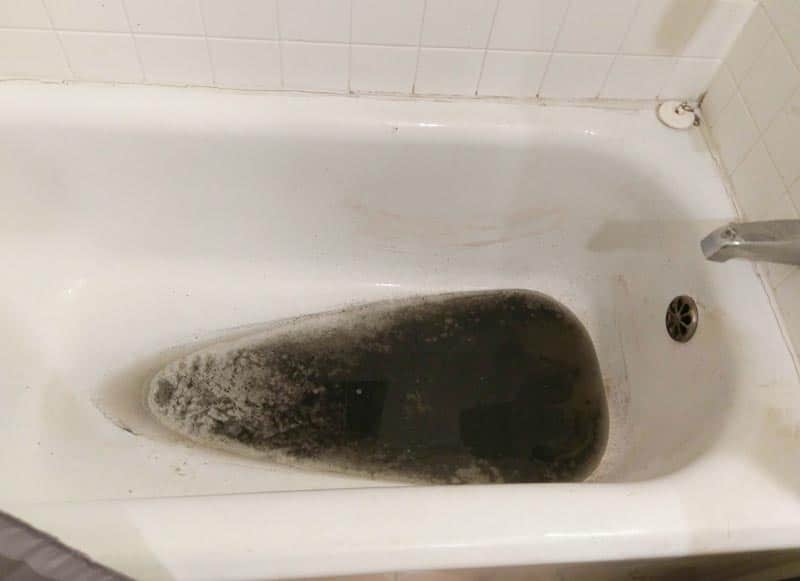Triggers for Waste Rising Through the Bathtub
Triggers for Waste Rising Through the Bathtub
Blog Article
They are making a number of good observations related to Why sewage is coming up through your bathtub as a whole in this post below.

Sewer backup in the bathtub can be a stressful and unsanitary trouble for any type of house owner. Not only is it inconvenient, yet it also positions serious health and wellness threats and shows underlying issues with the plumbing system. Recognizing why sewage is showing up with the tub is critical for taking proper activity to deal with the trouble successfully.
Introduction to the Issue
Common Factors for Sewer Back-up
Obstructions in the Drain Line
One of the most common sources of sewage backup is a blockage in the drain line. This can take place due to the build-up of debris, grease, or foreign things in the pipes, preventing correct circulation and causing sewage to support right into your bath tub.
Tree Origin Breach
Tree origins seeking moisture and nutrients can penetrate sewage system lines with small cracks or joints. With time, these origins can expand and expand, causing significant damages to the pipes and leading to sewage back-up concerns.
Understanding the Problem
When sewer starts backing up right into the bath tub, it's a clear indication of a problem with the drainage system. The wastewater that should be streaming far from your home is rather discovering its way back right into your home, which can bring about substantial damages and carcinogen.
Potential Reasons
Several factors can add to sewage back-up in the bath tub. From blockages in the sewage system line to concerns with the plumbing framework, identifying the origin is essential for finding a service.
Aging Framework
Older homes may have dated plumbing systems that are much more prone to rust, cracks, and deterioration. As pipes age, they end up being a lot more susceptible to leaks and clogs, raising the probability of sewage back-up events.
Heavy Rainfall or Flooding
During durations of heavy rainfall or flooding, the drain system may become overloaded with excess water, causing backups and overflows. This can lead to sewage backing up into bath tubs and other fixtures inside the home.
Indicators of Sewer Back-up
Foul Odors
Unpleasant smells originating from drains or fixtures, specifically in the bathroom, may indicate sewage backup concerns. These smells are often strong and relentless, indicating a problem that requires prompt interest.
Slow Draining Fixtures
Tubs, sinks, and toilets that drain pipes slowly or otherwise whatsoever could be experiencing sewage backup. If numerous components are influenced concurrently, it's likely that the issue originates from a typical point, such as the major drain line.
Gurgling Sounds
Weird gurgling or bubbling sounds coming from drains pipes when water is running elsewhere in your house are a sign of air trapped in the plumbing system. This air accumulation can arise from sewer backup and must be investigated quickly.
Health Threats Connected With Sewage Backup
Contamination of Water System
Sewer backup can contaminate the water supply in your home, posturing a significant health and wellness risk to you and your family members. Exposure to infected water can cause gastrointestinal problems, skin infections, and various other illnesses.
Mold Growth
Wetness from sewage backup can create suitable conditions for mold development in your home. Mold and mildew spores can intensify breathing issues and cause allergies in sensitive people, making punctual cleanup crucial.
Spread of Condition
Sewage consists of harmful microorganisms, infections, and parasites that can create a variety of diseases, including liver disease, cholera, and gastroenteritis. Coming into contact with sewer or polluted surface areas puts you at risk of infection.
Tidying up After Sewer Back-up
Sanitation Procedures
Thoroughly sanitize and disinfect impacted locations after sewer back-up to get rid of harmful germs and prevent mold and mildew development. Use ideal cleaning items and safety equipment to ensure safe and reliable cleanup.
Remediation of Impacted Areas
Repair any type of damages to floor covering, walls, or components caused by sewer backup. Relying on the extent of the damage, you might require to change carpeting, drywall, or various other products to recover your home to its pre-loss condition.
Immediate Actions to Take
Turning Off Supply Of Water
In case of sewer back-up, it's essential to shut off the water system to avoid further contamination and damages. Locate the primary water shutoff valve in your house and shut it off until the concern can be resolved.
Contacting an Expert Plumber
Dealing with sewer back-up is not a DIY task. Contact a licensed plumber with experience in taking care of sewage-related concerns to analyze the circumstance and do required repairs or clean-ups.
Staying Clear Of Contact with Polluted Water
Up until the sewage back-up is dealt with, avoid contact with polluted water to avoid the spread of germs and pathogens. Use safety equipment if you need to be in the afflicted area and wash your hands extensively later.
Safety nets
Normal Upkeep of Sewer Lines
Set up routine examinations and maintenance of your sewage system lines to recognize and attend to potential concerns prior to they escalate into significant issues. This can include cleaning particles, checking for tree origin invasion, and fixing any type of damaged pipes.
Installing Backwater Valves
Think about installing backwater valves in your plumbing system to prevent sewer from flowing back right into your home throughout durations of heavy rainfall or flooding. These shutoffs instantly close when water draws back up, safeguarding your home from contamination.
Correct Disposal of House Waste
Stay clear of purging anything other than toilet paper and human waste down the toilet to prevent obstructions and clogs in the drain line. Dispose of oil, oil, and other household chemicals appropriately to reduce the risk of plumbing issues.
Why is Sewage Coming Up Through Your Bathtub?
Reasons You May Have Sewage in Your Bathtub
All the drains in your home lead down different pipes to get to the main sewer line. If you’re seeing sewage in the bathtub, the problem is that the main sewer line is clogged up, which is causing the water running through other drains to be pushed back into other pipes. The problem isn’t the bathtub, but the main line. The sewer line can get backed up by anything that goes down the drain, from food waste, hair and soap particles to jewelry or children’s toys. Tree branches or dirt can also impact the sewer line. If you’re seeing sewage in the bathtub, you have a big problem that usually needs a professional plumber. Trying to fix this problem without the right tools or knowledge can lead to bigger plumbing problems.
Fixing a Clogged Sewage Line
Although you shouldn’t try to fix the clogged sewer line on your own, you may be able to mitigate the issue until you can get a plumber to your home. A plunger isn’t going to help, because it won’t be able to reach the sewage drain to unblock the problem.
Turn Off Water
Find the main shutoff valve to your home to turn off the water. This prevents more water from going down the drain which is only going to flow back into your bathtub.
Snake the Toilet and Drain
Start by using a drain pipe snake to clean out the toilet drain. Rotate the snake clockwise when you push the snake down. As you pull it out, the snake should spin counterclockwise. Follow up by snaking out the bathtub drain. If you are successful, both the toilet and shower will drain efficiently. If you’re not successful, you probably have a bigger problem than your tools and experience can manage.
Contact a Professional Plumber
Pros have the tools to find the source of the problem and the experience to manage big blockages without causing more damage to your pipes. It can save you a lot of stress by contacting the professionals sooner rather than later.
Identify the Early Signs of a Clogged Sewage Line
If you’re gearing up for a holiday family gathering or just want to avoid the hassle of a clogged sewage line in your home, make sure you recognize the signs of a clogged sewer line.
Slow drains are a sign of a sewer line problem. Gurgling drains from any drain in your home indicate that you may have an obstruction in the drains. If your toilet keeps getting clogged, it might be a problem with the sewer line. When you see laundry water or water from the dishwasher in different sinks in the home, it’s an indication that your sewer drain is beginning to get backed up. These symptoms can often be “fixed” temporarily to get through a day or week before you start seeing the same problem. When it comes to plumbing problems, you want to fix the root of the problem instead of muddling through. The clog will not go away on its own.
https://handymanconnection.com/mississauga/articles/why-is-sewage-coming-up-through-your-bathtub/

Do you like reading about Why is There Sewage Coming Up Through the Bathtub? Place a remark below. We would be delighted to see your insights about this blog post. We hope that you visit us again later on. Enjoyed reading our write up? Please quickly share it. Help somebody else locate it. Thank-you for going through it.
Request Appointment
Report this page